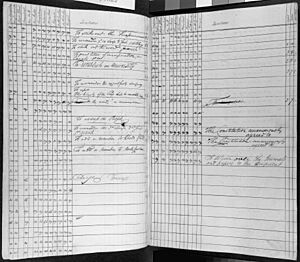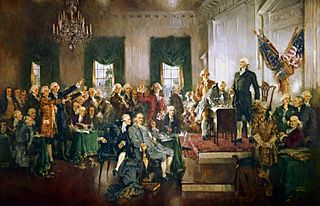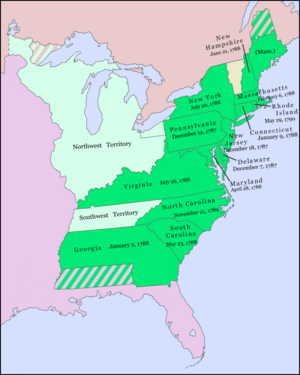Timeline of drafting and ratification of the United States Constitution facts for kids
The Constitution of the United States is the main rulebook for how the United States government works. It was created to replace an earlier set of rules called the Articles of Confederation, which weren't working very well. The process of writing this important document began on May 25, 1787. That's when a group called the Constitutional Convention met for the first time at the Pennsylvania State House (now known as Independence Hall) in Philadelphia, Pennsylvania. They met to make changes to the Articles of Confederation.
The work finished on September 17, 1787, when the new Constitution was adopted and signed. After that, the states had to approve it. This approval process, called ratification, started on the same day and ended on May 29, 1790, when Rhode Island became the last state to approve it.
This timeline shows important moments during the Constitutional Convention and the time when the states were approving the Constitution. It also includes key events that happened before the convention and when the country was changing from the old rules (Articles of Confederation) to the new ones (the Constitution). It even includes the special vote by the Vermont Republic, which was not yet part of the United States. This timeline covers events from March 25, 1785, to January 10, 1791.
Contents
1785: Early Meetings
Maryland and Virginia Discuss Waterways
- March 25 • Maryland–Virginia conference starts
- Delegates from Maryland and Virginia met at Mount Vernon, which was George Washington's home. They discussed how to share the waterways between their states, like the Potomac River. This meeting was supposed to be in Alexandria, Virginia a few days earlier. Important people there included Daniel of St. Thomas Jenifer, Thomas Stone, and Samuel Chase from Maryland, and George Mason and Alexander Henderson from Virginia.
- March 28 • Maryland–Virginia conference ends
- The delegates agreed on a thirteen-point plan, known as the Mount Vernon Compact. This plan set rules for trade, fishing, and travel on the Potomac and Pocomoke Rivers, and in Chesapeake Bay. Both the Virginia and Maryland governments later approved this agreement. It was the first agreement between states in the country.
1786: Calls for Change
States See Problems with Trade
- January 21 • Call for a conference to fix government problems
- The Virginia government asked for a meeting between states. The goal was to talk about and agree on how to remove trade barriers that made it hard for states to do business with each other.
- September 11 • Annapolis Convention starts
- Delegates from Delaware, New Jersey, New York, Pennsylvania, and Virginia met in Annapolis, Maryland. They wanted to find ways to make trade easier between states and create standard rules. Delegates from other states like Massachusetts, New Hampshire, North Carolina, and Rhode Island either arrived too late or didn't come. Four states—Connecticut, Georgia, Maryland, and South Carolina—didn't send any delegates.
- September 14 • Annapolis Convention ends
- The convention sent a report to the Congress and the state governments. It asked for another meeting to be held in Philadelphia the following May. This new meeting would discuss changing the Articles of Confederation.
States Choose Delegates
- November 23 •
- New Jersey chose its delegates for the planned constitutional convention. These included David Brearley, Jonathan Dayton, William Houston, William Livingston, and William Paterson.
- December 4 •
- Virginia chose its delegates. They were John Blair Jr., James Madison, George Mason, James McClurg, Edmund Randolph, George Washington, and George Wythe.
- December 30 •
- Pennsylvania chose its delegates. These included George Clymer, Thomas Fitzsimons, Benjamin Franklin, Jared Ingersoll, Thomas Mifflin, Gouverneur Morris, Robert Morris, and James Wilson.
1787: The Constitution is Born
More Delegates Are Chosen
- January 6 •
- North Carolina chose its delegates: William Blount, William Richardson Davie, Alexander Martin, Richard Dobbs Spaight, and Hugh Williamson.
- January 17 •
- New Hampshire chose Nicholas Gilman and John Langdon.
- February 3 •
- Delaware chose Richard Bassett, Gunning Bedford Jr., Jacob Broom, John Dickinson, and George Read.
- February 10 •
- Georgia chose Abraham Baldwin, William Few, William Houstoun, and William Pierce.
- February 21 • Convention to change the Articles of Confederation is called
- The Congress of the Confederation officially called for a constitutional convention. Its only goal was to change the Articles of Confederation. The changes would then be sent to Congress and the states for approval. This was to make the government strong enough to meet the country's needs and keep the states united.
- March 3 •
- Massachusetts chose Elbridge Gerry, Nathaniel Gorham, Rufus King, and Caleb Strong.
- March 6 •
- New York chose Alexander Hamilton, John Lansing Jr., and Robert Yates.
- March 8 •
- South Carolina chose Pierce Butler, Charles Cotesworth Pinckney, Charles Pinckney, and John Rutledge.
- April 23 •
- Maryland chose Daniel Carroll, Daniel of St. Thomas Jenifer, Luther Martin, James McHenry, and John Mercer.
- May 5 •
- Rhode Island's government voted against sending delegates to the convention.
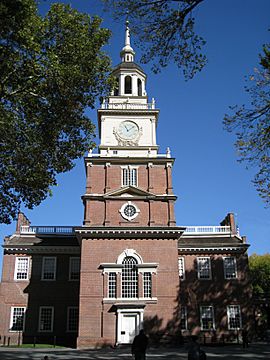
The Constitutional Convention Begins
- May 14 • Constitutional Convention scheduled to begin
- Only a few delegates had arrived in Philadelphia, so the meeting was delayed. Not enough people were there to start.
- May 14 •
- Connecticut chose Oliver Ellsworth, William Samuel Johnson, and Roger Sherman as its delegates.
- May 17 •
- Some citizens from Rhode Island sent a letter to the convention. They supported the work and were sad that their state wasn't taking part.
- May 25 • Constitutional Convention starts
- Enough delegates had arrived at the Pennsylvania State House to begin. The convention officially started its work. George Washington was chosen as the president of the convention. William Jackson was chosen as the secretary. Alexander Hamilton, Charles Pinckney, and George Wythe were picked to create the rules for the convention.
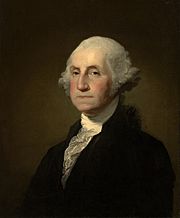
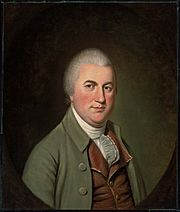
Plans for Government Are Proposed
- May 29 •
- Edmund Randolph presented the Virginia Plan. This plan, also called the Large State Plan, suggested how the federal government should be structured.
- May 29 •
- Charles Pinckney presented his own plan for the federal government, known as the Pinckney Plan.
- May 30 •
- Nathaniel Gorham was chosen to lead the Committee of the Whole, a group where all delegates could discuss ideas more freely.
- June 15 •
- William Paterson presented the New Jersey Plan. This plan, also called the Small State Plan, offered a different way to structure the federal government.
- June 18 •
- Alexander Hamilton presented his plan for the federal government, sometimes called the British Plan.
Key Decisions and Compromises
- July 2 •
- A group called the Committee of Eleven was chosen. It included Abraham Baldwin, Gunning Bedford, William Davie, Oliver Ellsworth, Benjamin Franklin, Elbridge Gerry, Luther Martin, George Mason, John Rutledge, William Paterson, and Robert Yates. Their job was to find a compromise on how states would be represented in the two parts of the federal legislature (Congress). These committees, with one delegate from each state, were often formed to help the convention move forward when they were stuck.
- July 12 •
- Delegates from states with slavery and states without slavery agreed on the Three-Fifths Compromise. This decided how enslaved people would be counted when figuring out how many representatives each state would get and how direct taxes would be shared.
- July 16 •
- The Committee of Eleven suggested a plan that was approved by the convention (5 states for, 4 against, 1 divided). This plan, known as the Connecticut Compromise or Great Compromise, suggested:
-
- Representation in the House of Representatives would be based on population.
- Each state would have an equal number of representatives in the Senate.
- All laws about money would start in the House.
- July 24 •
- The Committee of Detail was chosen. It included John Rutledge, Edmund Randolph, Nathaniel Gorham, Oliver Ellsworth, and James Wilson. Their job was to write the first draft of the Constitution based on the decisions made so far.
- August 6 •
- The Committee of Detail presented its report, which was a draft constitution with twenty-three articles and a preamble (an introduction).
- August 18 •
- Another Committee of Eleven was chosen to discuss issues like the federal government taking on state debts and matters related to the military.
- August 22 •
- A different Committee of Eleven was chosen to discuss federal taxes and duties, and the government's power to control or stop the import of enslaved people.
- August 25 •
- Another Committee of Eleven was chosen to look at issues related to trade and travel between states.
- August 31 •
- A "Leftover Business" Committee of Eleven was chosen. Their job was to finish up any parts of the Constitution that had been put aside and any reports that hadn't been acted on.
- September 1–8 •
- The "Leftover Business" Committee worked on several remaining issues. These included how to choose a president, how long a president would serve, the president's power to make treaties, and how to remove a president from office. They then presented their findings.
- September 8 •
- The Committee of Style and Arrangement was chosen. It included Alexander Hamilton, William Samuel Johnson, Rufus King, James Madison, and Gouverneur Morris. Their job was to take the twenty-three approved articles and turn them into a final, clear draft of the Constitution.
- September 12 •
- The Committee of Style and Arrangement presented the finished final draft of the Constitution to the convention. The twenty-three articles were now organized into a clear document with seven articles, an introduction (preamble), and a closing statement. Gouverneur Morris was the main writer of this final version. The committee also presented a letter to go with the Constitution when it was sent to Congress.
- September 13–14 •
- The official copy of the draft Constitution was carefully written out by hand by Jacob Shallus.
- September 15 •
- All the state delegations present agreed to the draft Constitution.
- September 17 • Constitution signed and convention ends
- Thirty-nine delegates from twelve states (all except Rhode Island) signed the approved Constitution. One delegate, John Dickinson, was sick and not there, so George Read signed for him. Three delegates who were present chose not to sign: Edmund Randolph, George Mason, and Elbridge Gerry. George Washington, as the president of the convention, signed first. The other delegates then signed, grouped by state. The convention then ended without setting a date to meet again.
The Constitution Goes to the States
- September 18 • Proposed Constitution published
- The Pennsylvania Packet newspaper printed the first public copies of the proposed Constitution in Philadelphia.
- September 20 •
- Congress received the proposed Constitution.
- September 27 •
- The first letter against the Constitution, by someone using the name "Cato," was published. These writers were called Anti-Federalists.
- September 28 •
- The Congress of the Confederation voted to send the proposed Constitution to the thirteen states. The states would then hold special meetings to decide if they would approve it, as explained in Article Seven of the Constitution.
- October 5 •
- The first Anti-Federalist letter by "Centinel" was published.
- October 8 •
- The first Anti-Federalist letter by "Federal Farmer" was published.
- October 18 •
- The first Anti-Federalist letter by "Brutus" was published.
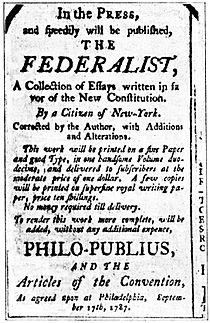
- October 27 •
- The first of The Federalist Papers was published. These essays were written by "Publius" (which was a pen name for Alexander Hamilton, John Jay, and James Madison). Hamilton's Federalist No. 1 appeared in The Independent Journal. The authors hoped these essays would "give a satisfactory answer to all the objections" from the Anti-Federalists.
- November 20 •
- The approval meeting began in Pennsylvania.
- December 3 •
- The approval meeting began in Delaware.
- Delaware became the first state to approve the Constitution (30 votes for, 0 against).
- December 11 •
- The approval meeting began in New Jersey.
- Pennsylvania became the second state to approve the Constitution (46 votes for, 23 against).
- New Jersey became the third state to approve the Constitution (38 votes for, 0 against).
- December 18 •
- The Anti-Federalist minority in Pennsylvania published their "Dissent," explaining why they disagreed with the Constitution.
- December 25 •
- The approval meeting began in Georgia.
1788: More States Approve
- Georgia became the fourth state to approve the Constitution (26 votes for, 0 against).
- January 3 •
- The approval meeting began in Connecticut.
- Connecticut became the fifth state to approve the Constitution (128 votes for, 40 against).
- January 9 •
- The approval meeting began in Massachusetts.
- Massachusetts became the sixth state to approve the Constitution (187 votes for, 168 against). Along with approving the Constitution, Massachusetts asked for nineteen changes to be made to it.
- February 13–22 •
- The first approval meeting was held in New Hampshire.
- March 1 •
- The Rhode Island government ignored the rules of Article Seven of the Constitution. Instead of holding a special meeting, they called for a public vote across the state.
- March 24 •
- Voters in Rhode Island strongly rejected the Constitution (2,708 votes against, 237 for).
- April 10 •
- The Albany Antifederal Committee published a letter strongly disagreeing with the proposed Constitution. They said the new government would be "more unfair and like a dictator than that of Great Britain."
- April 21 •
- The approval meeting began in Maryland.
- Maryland became the seventh state to approve the Constitution (63 votes for, 11 against).
- May 12 •
- The approval meeting began in South Carolina.
- South Carolina became the eighth state to approve the Constitution (149 votes for, 73 against). South Carolina also asked for two changes to be made to the Constitution.
- June 2 •
- The approval meeting began in Virginia.
- June 17 •
- The approval meeting began in New York.
- June 18 •
- The second approval meeting began in New Hampshire.
- New Hampshire became the ninth state to approve the Constitution (57 votes for, 47 against). New Hampshire also asked for twelve changes to be made to it.
- June 21 •
- With nine of the thirteen states having approved it, the Constitution was officially established. It now took effect for those nine states.
- Virginia became the tenth state to approve the Constitution (89 votes for, 79 against). Virginia also asked for 20 changes to be made to it.
- July 2 •
- Congress President Cyrus Griffin told Congress that New Hampshire had approved the Constitution. He noted that this was the ninth approval they had received. A committee was formed to look at all the approvals and create a plan for starting the new government under the Constitution.
- July 21 – August 2 •
- The first approval meeting was held in Hillsborough, North Carolina. Delegates voted (184 against, 84 for) neither to approve nor reject the Constitution. They hoped to add a bill of rights to the government's rules.
- New York became the eleventh state to approve the Constitution (30 votes for, 27 against). New York also sent a letter asking for 33 changes to be made. They also asked the new United States Congress to act on all the changes requested by other states.
- September 13 •
- The Congress of the Confederation confirmed that the new Constitution had been properly approved. It set dates for the first meeting of the new federal government and the presidential election.
- December 15, 1788 – January 10, 1789 • Presidential election held
- The first presidential election under the new Constitution was held. This election happens every four years.
1789: The New Government Begins
- February 4 • Presidential electors meet
- The Presidential electors met in their states to cast their votes. George Washington was chosen by everyone to be the nation's first president. John Adams was chosen as the first vice president. Only ten of the thirteen states voted in this election. North Carolina and Rhode Island couldn't participate because they hadn't approved the Constitution yet. New York's government didn't choose its electors in time, so New York didn't have any votes.
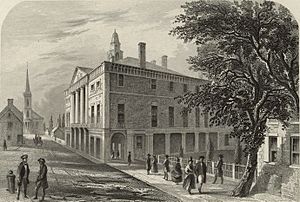
- March 4 • United States Congress meets
- The federal government officially began operating under the new Constitution. Members of the 1st United States Congress gathered at Federal Hall in New York City. The Senate had 20 Federalists (who supported the Constitution) and two Anti-Federalists (who opposed it). The House had 48 Federalists and 11 Anti-Federalists. However, the first meeting of each group had to be delayed because not enough members were present to start.
- April 1 • House of Representatives has enough members to start
- With enough members present, the representatives began their work. Frederick Muhlenberg of Pennsylvania was chosen as the Speaker of the House.
- April 6 • Senate has enough members to start
- With enough members present, the senators began their work. John Langdon of New Hampshire was chosen as the temporary leader of the Senate.
- April 6 • Presidential votes counted
- The House and Senate met together and officially confirmed that George Washington had been elected President and John Adams Vice President.
- April 21 • John Adams starts as Vice President
- John Adams was sworn in as Vice President of the United States in the Senate chamber at Federal Hall in New York City.
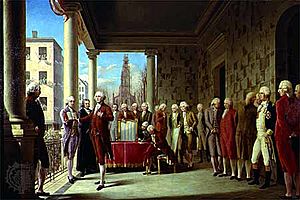
- April 30 • George Washington starts as President
- George Washington was officially sworn in as President of the United States at Federal Hall in New York City. He placed his hand on a Bible from St. John's Lodge No. 1, A.Y.M., as Chancellor of New York Robert Livingston gave him the presidential oath.
- September 25 • Constitutional changes proposed by Congress
- Twelve proposed changes to the Constitution were approved by the Senate, after being passed by the House the day before. These were sent to the states for approval. Changes Three through Twelve were approved by the states on December 15, 1791, and are known together as the Bill of Rights. Change Two became part of the Constitution on May 7, 1992, as the Twenty-seventh Amendment. Change One is still waiting to be approved by the states.
- November 16 •
- The second approval meeting began in Fayetteville, North Carolina.
- North Carolina became the twelfth state to approve the Constitution (194 votes for, 77 against). North Carolina also asked for twenty-six changes to be made to it.
1790: The Last State Approves
- February 2 • Supreme Court of the United States meets
- The Supreme Court of the United States held its first meeting with enough judges present at the Royal Exchange Building in New York City. Chief Justice John Jay led the meeting. As set by the Judiciary Act of 1789, the Supreme Court would start with one chief justice and five other judges.
- March 1–6 •
- The first approval meeting was held in Rhode Island.
- May 24 •
- The second approval meeting began in Rhode Island.
- Rhode Island became the thirteenth and final state to approve the Constitution (34 votes for, 32 against). Rhode Island also asked for twenty-one changes to be made to it.
1791: Vermont Joins
- January 6 •
- A meeting began in Vermont to consider joining the United States.
- Vermont voted to approve the Constitution and to ask to join the United States (105 votes for, 2 against).
Images for kids
-
Original parchment pages of the United States Constitution


